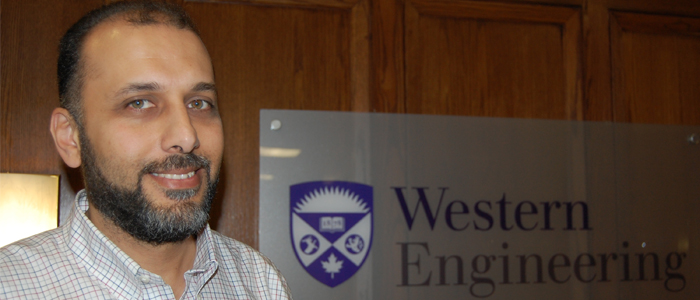Media
Contact
Communications Specialist
Faculty of Engineering
Spencer Engineering Building
Room 2072
Western University
Tel: 519-661-2111 ext. 87015
Email: engineeringcomms@uwo.ca
'Groundbreaking' research improves box culvert designs

Western Engineering News | October 22, 2014
By Jason Teakle
Osama Abuhajar has received accolades for his research into improving the design guidelines for box culverts.
Abuhajar completed his PhD in Civil and Environmental Engineering in September 2013 and took home the Canadian Geotechnical Society’s 2014 Graduate Student Presentation Competition Award at the southwestern Ontario division in Toronto. Abuhajar later presented his dissertation entitled, “Static and Seismic Soil Culvert Interaction” to about 500 people at the Canadian Geotechnical Society’s Annual Conference in Regina on Sept. 30, 2014, and nabbed first-place Award for his dissertation.
Box culverts are common structures that are used for many engineering and construction purposes.
"Box culverts can be used for creeks to pass under roads, subways, extending pipelines and under bridges for pedestrians and cars to pass underneath," he explained. You can find box culverts that were built in the past, which didn't show large failures, but that doesn't mean the designs were economical.
“Seismically, box culverts can be subjected to sudden increases in soil pressure due to ground shaking or ground failures, such as liquefaction," said Abuhajar.
The design of box culverts relies on empirical equations and experience. The guidelines for designing them are very limited and there has not been a lot of research completed on them.
The research conducted for his dissertation involved comprehensive geotechnical centrifuge tests and numerical modeling of box culverts to improve design guidelines, said Abuhajar.
"Centrifuge is a tool you can use to model large-scale problems on smaller scales and obtain the data you want," he said. "This data is used to investigate the effect of soil arching on the values of soil pressure attracted to the box culvert, depending on soil density, surface foundation and culvert thickness."
Soil arching refers to an increase or decrease in soil pressure around a box culvert, he notes.
"To investigate soil arching, you need to study the soil structure interaction under the static and seismic loads. The existence of the structure inside the soil causes soil arching to happen."
The geotechnical centrifuge tests conducted by Abuhajar involved a series of measurements, such as soil pressures through strain gauges and tactile pressure sensors and acceleration time history during earthquakes.
"I completed a comprehensive static and seismic parametric study to see the effect of soil heights above the culvert, different culvert thicknesses and different soil properties."
The data gained from the project will allow engineers to design improved box culverts in the future, noted Abuhajar.
"Based on all this comprehensive study, new static and seismic design guidelines were developed to help civil engineers be able to do more safe and economical analysis and design of box culverts," noted Abuhajar. "This research work will allow civil engineers to design, build and install more reliable box culverts in the future."

